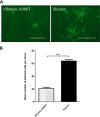The Unique Glycosylation at Position 986 on the E2 Glycoprotein of Classical Swine Fever Virus Is Responsible for Viral Attenuation and Protection against Lethal Challenge
- PMID: 34730400
- PMCID: PMC8791258
- DOI: 10.1128/JVI.01768-21
The Unique Glycosylation at Position 986 on the E2 Glycoprotein of Classical Swine Fever Virus Is Responsible for Viral Attenuation and Protection against Lethal Challenge
Abstract
Classical swine fever (CSF) is an economically important disease of pigs caused by classical swine fever virus (CSFV). The live attenuated vaccine C-strain (also called HCLV strain) against CSF was produced by multiple passages of a highly virulent strain in rabbits. However, the molecular determinants for its attenuation and protection remain unclear. In this study, we identified a unique glycosylation at position 986 (986NYT988) on the E2 glycoprotein Domain IV of C-strain but not (986NYA988) the highly virulent CSFV Shimen strain. We evaluated the infectivity, virulence, and protective efficacy of the C-strain-based mutant rHCLV-T988A lacking the glycosylation and Shimen strain mutant rShimen-A988T acquiring an additional glycosylation at position 986. rShimen-A988T showed a significantly decreased viral replication ability in SK6 cells, while rHCLV-T988A exhibited a growth kinetics indistinguishable from that of C-strain. Removal of the C-strain glycosylation site does not affect viral replication in rabbits and the attenuated phenotype in pigs. However, rShimen-A988T was attenuated and protected the pigs from a lethal challenge at 14 days postinoculation. In contrast, the rHCLV-T988A-inoculated pigs showed transient fever, a few clinical signs, and pathological changes in the spleens upon challenge with the Shimen strain. Mechanistic investigations revealed that the unique glycosylation at position 986 influences viral spreading, alters the formation of E2 homodimers, and leads to increased production of neutralizing antibodies. Collectively, our data for the first time demonstrate that the unique glycosylation at position 986 on the E2 glycoprotein is responsible for viral attenuation and protection. IMPORTANCE Viral glycoproteins involve in infectivity, virulence, and host immune responses. Deglycosylation on the Erns, E1, or E2 glycoprotein of highly virulent classical swine fever virus (CSFV) attenuated viral virulence in pigs, indicating that the glycosylation contributes to the pathogenicity of the highly virulent strain. However, the effects of the glycosylation on the C-strain E2 glycoprotein on viral infectivity in cells, viral attenuation, and protection in pigs have not been elucidated. This study demonstrates the unique glycosylation at position 986 on the C-strain E2 glycoprotein. C-strain mutant removing the glycosylation at the site provides only partial protection against CSFV challenge. Remarkably, the addition of the glycan to E2 of the highly virulent Shimen strain attenuates the viral virulence and confers complete protection against the lethal challenge in pigs. Our findings provide a new insight into the contribution of the glycosylation to the virus attenuation and protection.
Keywords: C-strain; attenuation; classical swine fever virus; glycosylation; protection.
Figures








Similar articles
-
P108 and T109 on E2 Glycoprotein Domain I Are Critical for the Adaptation of Classical Swine Fever Virus to Rabbits but Not for Virulence in Pigs.J Virol. 2020 Aug 17;94(17):e01104-20. doi: 10.1128/JVI.01104-20. Print 2020 Aug 17. J Virol. 2020. PMID: 32581110 Free PMC article.
-
Removal of a N-linked glycosylation site of classical swine fever virus strain Brescia Erns glycoprotein affects virulence in swine.Virology. 2008 Jan 5;370(1):122-9. doi: 10.1016/j.virol.2007.08.028. Epub 2007 Sep 29. Virology. 2008. PMID: 17904607
-
Recoding structural glycoprotein E2 in classical swine fever virus (CSFV) produces complete virus attenuation in swine and protects infected animals against disease.Virology. 2016 Jul;494:178-89. doi: 10.1016/j.virol.2016.04.007. Epub 2016 Apr 26. Virology. 2016. PMID: 27110709
-
Approaches to define the viral genetic basis of classical swine fever virus virulence.Virology. 2013 Apr 10;438(2):51-5. doi: 10.1016/j.virol.2013.01.013. Epub 2013 Feb 13. Virology. 2013. PMID: 23415391 Review.
-
The challenges of classical swine fever control: modified live and E2 subunit vaccines.Virus Res. 2014 Jan 22;179:1-11. doi: 10.1016/j.virusres.2013.10.025. Epub 2013 Nov 6. Virus Res. 2014. PMID: 24211665 Review.
Cited by
-
Cross-reactivities and cross-neutralization of different envelope glycoproteins E2 antibodies against different genotypes of classical swine fever virus.Front Vet Sci. 2023 Apr 27;10:1169766. doi: 10.3389/fvets.2023.1169766. eCollection 2023. Front Vet Sci. 2023. PMID: 37180072 Free PMC article.
-
Evolutionary-Related High- and Low-Virulent Classical Swine Fever Virus Isolates Reveal Viral Determinants of Virulence.Viruses. 2024 Jan 19;16(1):147. doi: 10.3390/v16010147. Viruses. 2024. PMID: 38275957 Free PMC article.
-
Generation of Vaccine Candidate Strains That Antigenically Match Classical Swine Fever Virus Field Strains.Vaccines (Basel). 2025 Feb 14;13(2):188. doi: 10.3390/vaccines13020188. Vaccines (Basel). 2025. PMID: 40006734 Free PMC article.
-
Viral Live-Attenuated Vaccines (LAVs): Past and Future Directions.Adv Sci (Weinh). 2025 Jan;12(3):e2407241. doi: 10.1002/advs.202407241. Epub 2024 Dec 6. Adv Sci (Weinh). 2025. PMID: 39639853 Free PMC article. Review.
References
Publication types
MeSH terms
Substances
LinkOut - more resources
Full Text Sources

